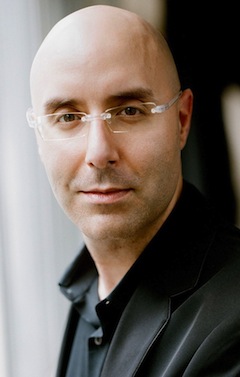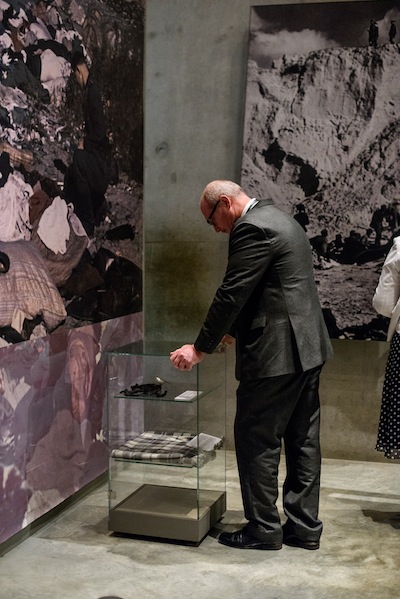 On July 10, at Givat Olga, Indian Prime Minister Narendra Modi, centre-left, and Israeli Prime Minister Binyamin Netanyahu sample water that has just been purified to the World Health Organization standard in the Galmobile. In February 2015, Gal Water Technologies Co., from nearby Caesarea, launched the mobile water purification system. The small vehicle, the first of its kind in the world, weighs 1,540 kilograms, operates on a 12-volt electric supply and can be set up in less than half an hour. It can connect to almost any water source. (photos from Ashernet)
On July 10, at Givat Olga, Indian Prime Minister Narendra Modi, centre-left, and Israeli Prime Minister Binyamin Netanyahu sample water that has just been purified to the World Health Organization standard in the Galmobile. In February 2015, Gal Water Technologies Co., from nearby Caesarea, launched the mobile water purification system. The small vehicle, the first of its kind in the world, weighs 1,540 kilograms, operates on a 12-volt electric supply and can be set up in less than half an hour. It can connect to almost any water source. (photos from Ashernet)
Tag: technology
Marketing of technology
Yonatan Avraham, student ambassador of HUstart, left, and Tamir Huberman of Yissum are two of the four speakers who will be participating in Jerusalem of Gold: Capital of Innovation & Tech on July 16. (photos from CFHU Vancouver)
“I have always loved the thrill you feel while creating your own project, seeing it grow and being responsible for the outcomes – and the satisfaction you feel while convincing a stranger to give his or her resources (time or money) for your product,” said Yonatan Avraham, student ambassador of HUstart, Hebrew University of Jerusalem’s entrepreneurship centre, about what excites him about being an innovator and entrepreneur.
Avraham is one of four speakers who will participate in Jerusalem of Gold: Capital of Innovation & Tech, which will take place on July 16 at the Jewish Community Centre of Greater Vancouver. The event is being hosted by Canadian Friends of the Hebrew University, the Jerusalem Foundation and JCCGV. Avraham will be joined by Lior Schillat of Jerusalem Institute for Policy Research; Maya Halevy of Bloomfield Science Museum Jerusalem; and Tamir Huberman of Yissum, HU’s technology transfer company. The Jewish Independent’s interviews with Schillat and Halevy appeared in last week’s issue (see jewishindependent.ca/jerusalem-a-high-tech-hub).
“All of the speakers are coming from Israel especially for this tour in Western Canada. We will be in Vancouver on July 16, Calgary on July 17 and Edmonton on July 18,” said Dina Wachtel, Western region executive director of CFHU, of the tour, which celebrates the 50th anniversary of the reunification of Jerusalem.
“Tamir is going to give a talk on Friday, July 14, at Simon Fraser University titled The Power of Social Networks: Boosting the Marketing of Innovations, organized by Fred Popowich, executive director of Big Data Initiative at Simon Fraser University,” she said. “Part of our mandate is to create these living bridges between Hebrew U and our local universities; hence, this is part of this initiative.”
Huberman is Yissum’s vice-president of business development and director of information technology. At the JCCGV, he will talk on Marketing Innovation: Changing Israel and the World.
In the press material, Huberman notes, “As the only university in Israel with a school of agriculture, research in non-GMO hybrid seeds at Hebrew U is changing the way millions of people eat now and into the future.” He also notes that Mobileye, which recently sold to Intel for $15.3 billion US, was founded by HU Prof. Amnon Shashua.
Yissum “operates on a royalty-based model which channels proceeds from successful products back to the researchers, their labs and the university itself,” he explains. It also generates funds “by attracting corporations to collaborate with Hebrew University labs to find the answers the businesses are seeking.”
About what B.C. (and other) universities could learn from HU, Huberman told the Independent, “I believe that the top lessons are how to be more effective and how to remove barriers for doing business. In most cases, tech transfer companies around the world are [viewed] as a bureaucratic entity that complicates things. The greatest lesson is making adaptations that would make things simpler for the companies that want to do business with us…. The second lesson is the realization that, for each new technology, there either has to be someone in the world that would be interested in acquiring a licence, or someone in the world that knows the technology does not have a chance. It is the ‘job’ of the tech transfer to find that ‘someone’ and, from my experience, the best way to do that is by using social networks. The revolution of social media allows getting fast replies from people all around the world, even if you’ve never met them.”
Huberman has always loved innovation and, he said, “it was a big dream of mine to be an inventor and work with new inventions.”
While working for the company Medis from 1996 to 2002, he was exposed to the world of patents and the process of writing patents as an inventor. “After my own experience as an inventor,” he said, “I knew I had to find a place that works with new patents at a massive scale.”
It was his “strong passion for new patents and ideas that was the top reason for joining Yissum,” he said. “Second was the opportunity to work with some of the most brilliant researchers in their fields. Third was my realization that there was something missing at the time before I joined Yissum, which had to do with the very low use of the internet in order to expose the technologies from the universities to the world.
“Before I arrived at Yissum, I made a simple search using freely available patent databases and saw that only a small fraction of the patents I found [were] on the tech transfer websites. When I realized this, I had a vision of changing how tech transfer companies worked…. My dream materialized when I created the first portal for all the technologies at Yissum and later created the ITTN website (Israel Technology Transfer Organization). ITTN was the first website in Israel that allowed all of the inventions from academic institutions in Israel to be found in one central portal.”
He added, “I believe that there is a lot that can be done to make a better and faster connection between companies seeking talent or innovation to the offerings of universities…. [B]uilding a portal that connects more universities in Israel and the world could help make that matching much more efficient.
“Another realization is that tech transfer companies traditionally showcase technologies and I believe that this is not the best approach…. [T]he portals should focus on the researchers and their capabilities, rather than just the patents that a small portion of them invented. We have multiple examples of companies that were interested in researchers that we did not even know [because] they never had any patents.”
One of the jobs of HUstart – of which Yissum is part, along with HU’s science faculty and business school – is to provide “practical education, support, mentorships and connections needed” for students and others “to become effective entrepreneurs.”
Avraham is a third-year physics student at Hebrew U and is in the first cohort of the new Physics and Entrepreneurship program, which connected him – during his second year of study – with his business partners. Avraham and fellow students Michael Levinson and Tom Zelanzy co-founded the start-up Gamitee, which “links social media and shopping websites, making it possible for friends to easily invite others to join them in a shopping experience.”
Avraham has other ideas, such as one for an “infant sleeper that monitors a baby’s vital signs, a technology that could potentially prevent SIDS.” And he and his wife – who is an archeologist – also run a tutoring business. In Vancouver, he will speak on The Making of a Serial Entrepreneur.
“I think they have a lot of similarities,” he said about physics and building a tech start-up. “In both, you need to solve complex questions and problems that are comprised of several independent factors. Both of them are professions that people rarely choose. And they are both very, very hard to understand. I think my physics background [increased] my range of abilities needed [to be] an entrepreneur.”
Jerusalem of Gold: Capital of Innovation & Tech is open to the public. Tickets are $45, though students who register at the CFHU office can receive a free ticket. For tickets and the speakers’ bios, visit cfhu.org, email vanc@cfhu.org or call 604-257-5133.
Digital marketing expertise
Mitch Joel is an expert in digital marketing, a sought-after speaker and an author.
Twenty years ago, the president of Mirum – a marketing agency operating in more than 45 offices around the globe, with more than 2,500 employees – was the editor of In Montreal, a newspaper geared to the university-aged set of Federation CJA. Among other endeavours along his media path, he was editor of two boutique music magazines and he co-launched Distort Entertainment.
Last week, Joel was one of the keynote speakers at the Call to Action Conference in Vancouver. His professional mission, he told the Independent, is to help companies “figure out how to transform their business in this digital world,” while “taking large, complex, usually highly regulated organizations and brands, and helping them make a big shift.”
In 2002, Joel joined digital marketing company Twist Image, whose clients included Home Depot, Microsoft, Fujifilm and other corporations and financial institutions. Three years ago, Twist was acquired by WPP, the largest marketing communications network in the world – worth $30 billion US – and it became Mirum.
To keep his proverbial finger on the pulse of industry trends, Joel uses a skill set honed early in his career.

“My first real job was in journalism,” he said. “A ‘nose for news’ doesn’t just apply to journalists, it applies to life. It’s a curiosity. It’s not really satiable, so I can’t imagine not having an entrepreneurial spirit, even if I was an entry-level employee.”
In addition to having one’s antennae always up, Joel encourages businesspeople to not fly solo, if they can help it. “Choosing that partner – making sure it’s the right fit – is really critical,” he said, noting that Mirum’s corporate leaders complement each other in their abilities. “We each hate what the other one is doing,” he said, with a chuckle.
Knowing one’s strengths and weaknesses is important, and so is knowing to whom your product or service is directed, he said. Joel is less interested in making broad generalizations of any generation – be it boomer, Gen X or millennial – than on the type of consumer.
“Selling to moms is very different than if we are selling to healthcare professionals. Selling to healthcare professionals is very different than selling to a group you are trying to get to open a checking account,” he explained. “I know a lot of people are making a lot of money on, ‘How do you speak to millennials?’ I think it is really hard to look at millennials and say they are a segment. You are talking about people of different gender, people of different interest levels, people of different education, people of different geography.”
In addition to his speaking engagements and corporate marketing advising, Joel has imparted some of his advice via two bestselling books. His first, Six Pixels of Separation, was named after his popular blog and podcast, and his second, CTRL ALT Delete, was named one of the best business books of 2013 by Amazon.
In CTRL ALT Delete, Joel discusses “flow,” a figurative time-management, three-legged stool, consisting of the personal, communal and professional. It’s a balancing act with which the husband and father of three still struggles.
“I just try to make sure that there is a balance of that stool because, if one leg is shorter than the other, it’s going to tip over,” he said.
But that doesn’t mean that work and family can’t overlap.
“I don’t consider it stressful to look at my inbox or think about a project when I’m not in the office. And vice versa, when I’m in the office, I might take off because there’s something with my kids, or there’s another thing I can do, and I can pick up on the work a little bit later,” he explained. “I’m not 100% successful all the time at hitting that balance, and there are moments when that stool looks like it’s tipping over dramatically. But, I’m aware of it and I think about it, and I focus on that – and I don’t beat myself up over it.”
Dave Gordon is a Toronto-based freelance writer whose work has appeared in more than 100 publications around the world.
Failure is a possibility
Israeli culture does not encourage failure; rather, it is somehow more tolerant and accepting of it. (photo from Shutterstock.com via Israel21c)
When was the last time you admitted you failed? Have you ever felt comfortable talking about your failures? How often do you use the word “failure” in daily life? How does even thinking about failing make you feel?
Legendary American football coach Vince Lombardi once said, “It’s not whether you get knocked down; it’s whether you get up.”
This reminds me of a cult TV show that I used to watch growing up in Israel, Zehu-Ze (That’s It). It had a character by the name of Yatzek, who discovered interesting places all over Israel and the kids watching the show had to guess where he was.
At the end of each episode, Yatzek would fall in a different way: from a tree, into the river, from the back of a horse, and even into cow manure. Naturally, the kids who were watching would be concerned. To reassure them, he always said, “Kids, no need to worry: Yatzek always falls and gets back up.” An entire generation of Israeli kids grew up with this strong message on a weekly basis.
I believe our culture has a very strong influence on our failures and, mostly, on our attitude toward these failures.
In late 2006, I joined the founding team of Modu. Modu was founded by serial entrepreneur Dov Moran, who previously led M-Systems to one of the biggest mergers and acquisitions in the history of Israeli high-tech. In a very short time, Modu raised more than $120 million, recruited more than 200 employees in Israel and abroad, opened a few subsidiaries around the world, and developed and manufactured two consumer products. All elements for success were present and yet, only three years after its inception, the company closed its doors.
But many Modu employees decided to start their own start-ups, including me. Out of this one big failure, dozens of new business ventures were initiated. How could it be that people who were part of such a huge investment in time, energy, resources and sacrifices were not discouraged after being part of a failed start-up? Rather, they decided to invest more energy, take more risks and start ventures of their own. This is a bold move, since statistically 90% of start-ups fail and the 10% of start-ups that make it are likely to fall apart along the way.
What is it that drives people to try despite the risk of failure? Is it possible that people’s level of comfort with failure is somehow related to their culture, as demonstrated by Yatzek, the crazy character that kept falling and getting up?
The Oxford Dictionary defines failure as “lack of success.” You have either succeeded or failed. It’s a binary game. On the other hand, if you look at the definition of failure in Hebrew, it is much more fluid: “someone that tripped, made an error, did not succeed.” Our language is a mirror of our culture. Informal messaging plays a major role in the values we learn from a very young age.
In Hebrew, adolescence or teenage years are referred to as “the foolish age.” At this age, people tend to act without thinking, resulting in many failures. Therefore, the terminology only reflects their inherent nature. When society regards them as such, as evident in Israel, it gives young people the chance to follow their natural way and experience what might be regarded as foolish – before they become young adults.
Even the Israeli military seems more tolerant of failures relative to other military organizations worldwide. The Air Force Academy teaches how to cope with failures as an essential part of regular conduct drills. After every single flight, the crew gathers in the “investigation room” and the pilot debriefs on what was successful and what was not, in front of a squadron of 40 fighters. The focus is on learning from mistakes and not to make the same mistake twice.
Israeli culture does not encourage failure; rather, it is somehow more tolerant of it and accepts it in such a way that we keep getting back up, trying, moving forward and advancing.
On a personal and professional level, I admit, I fail at least once a day. From this, I’ve learned that one of the things that really makes me happy is that my children are growing up in Israel, where we have the unique ability, as a culture, to look at any event head-on, success or failure, and discuss and learn from it.
I wish all of us could give our kids the understanding that the process is sometimes more important than the outcome, that failures are part of life and that what really matters is how you pick yourself up.
Don’t be afraid to fall. Let your kids fail, too. Just make sure to teach them to get up and never stop trying.
Inbal Arieli was a lieutenant in the elite Israel Defence Forces intelligence 8200 unit and later took leading roles in the Israeli high-tech sector. She is a senior advisor to Start-Up Nation Central and is currently co-chief executive officer of Synthesis. Featured as one of the “100 Most Influential People in Israeli High-Tech,” Arieli is working on an exploration of how Israeli culture breeds entrepreneurs from a young age. Israel21c is a nonprofit educational foundation with a mission to focus media and public attention on the 21st-century Israel that exists beyond the conflict. For more, or to donate, visit israel21c.org.
International partners
Left to right: Larry Fisher (Lark Group), David Berson (Canadian Associates of Ben-Gurion University of the Negev), Daniel Blumenthal (Centre for Digital Innovation Negev), Dianne Watts (South Surrey-White Rock MP) and Rowena Rizzotti (Health and Technology District). (photo by Yvonne Chiang)
The Health and Technology District in Surrey and the Centre for Digital Innovation in Israel have formalized a number of collaborations on health-related technologies, creating an international network between partners to support health-tech innovations in Israel and across North America.
The Centre for Digital Innovation (CDI) is located in the Advanced Technology Park in Be’er Sheba, Israel, the growing “Silicon Valley” of the Middle East. CDI is a nonprofit created through the collaborative efforts of Israeli entrepreneurs and Ben-Gurion University of the Negev. CDI operates in the areas of digital healthcare, healthy aging, education and smart cities, and brings together experienced entrepreneurs, start-up companies, innovators, researchers, industry leaders, academics, the public sector and investors to generate a high return on innovation for the challenges of the 21st century, such as the cost of healthcare and chronic diseases.
“Both CDI and Surrey’s Health and Technology District [HTD] have aggressive goals to drive innovation across the health sector and Canada stands to deeply benefit from the mentorship and leadership that Israel can bring to our innovation agenda here in Canada,” said Rowena Rizzotti, vice-president of health and innovations for HTD.
The memorandum of understanding between HTD and CDI will co-create and share respective solutions to global healthcare challenges by expediting the implementation of innovations in critical healthcare improvements for both countries.
“It’s great to see that Canada and Israel have parallel visions and focus in developing high-level innovations,” said Ziv Ofek, CDI founder and chief executive officer. “We are excited about this partnership with Canada and with the Health and Technology District and we look forward to collaborating and working together to create technologies that will benefit the world in which we live.”
The partnership was finalized during a recent trade mission organized by the Conference Board of Canada, where participants studied the culture and key success factors that have led to Israel’s groundbreaking developments in innovation and commercialization.
“Israel is a hotbed of high-tech innovations and boasts world-class skills and capabilities with universities and forward-thinking organizations developing some of the world’s latest technology breakthroughs,” said Paul Preston, Conference Board of Canada. “It’s hugely beneficial for Canadians to learn from this success and assist us in developing the talent and capacity to lead a culture in innovation in Canada.”
Every year, the Centre for Israel and Jewish Affairs (CIJA) brings more than 100 Canadians to visit and learn firsthand from the “start-up nation,” and has facilitated trips in recent years for the City of Surrey, the Government of British Columbia and the Conference Board of Canada.
“This exciting partnership is a prime example of how, in bringing the best Canadian and Israeli minds together, we can achieve remarkable things for both countries,” said Jason Z. Murray, CIJA Pacific Region chair.
HTD held a celebratory reception on March 23 with CDI and special guests Dianne Watts, member of Parliament for South Surrey-White Rock, Ofek and members of CIJA.
Developed by the Lark Group, a Canadian-based company, HTD is a series of high-tech buildings located immediately adjacent to Surrey Memorial Hospital, creating an ecosystem for clinicians and health-care providers to work alongside innovators, entrepreneurs and tech companies.
High-tech, fashionable art
Fashion designer Noa Raviv (photo by Ryan Duffin)
Avant-garde fashion designer Noa Raviv says her award-winning fashions were triggered by her interest in the power of mistakes.
Born in Tel Aviv in 1987, Raviv is currently developing her couture brand in New York City, after achieving global industry recognition for her Hard Copy garments combining hand-sewn, 3D-printed polymer synthetic tulle with laser-cut appliqués.
“Hard Copy was a really long process that came out of my thinking about the concept of originals and copies in our era,” she told Israel21c. “When I started working with 3D software and printing, I was intrigued by the mistakes I made. If you input a command that can’t be executed, you get unexpected results. It was kind of magical to me. I was fascinated by mistakes created by a perfect machine and started exploring how it could be my answer to designing something original – because a mistake is something you can’t replicate.”
Hard Copy features ribbed polymer shapes printed out on a Stratasys Objet Connex multi-material machine and stitched to voluminous pleated tulle, silk and organza.
Named Fashion Designer of the Year 2014 at the 3D Printshow in London, Raviv has exhibited in Carrousel du Louvre, Paris; Old Billingsgate, London; New York’s Metropolitan Museum of Art; and Boston’s Museum of Fine Arts, among other venues.
In November 2015, Raviv gave a keynote talk on The Power of Mistakes, at Futurescan 3, a conference organized by FTC (Association of Degree Courses in Fashion and Textile) at Glasgow School of Art in Scotland. She spoke on the same topic at the Museum of Design in Atlanta, Ga.
Raviv was one of four innovative Israeli women honoured at the 10th annual Israel Day at the New York Stock Exchange, Nov. 10, 2016.
Raviv, who appeared on Forbes Israel’s 2016 “30 Under 30” list, said she is “fascinated by the tension between harmony and chaos, tradition and innovation,” and wants to continue experimenting with technology.
Her current collection, Off-Line, was released in spring/summer 2016.

Though it’s not 3D-printed, Off-Line combines elements of complex handwork and machine work, beginning with graphic design software and topped off with Swarovski crystals.
Raviv’s collaboration with Swarovski involves sending design files to Austria, where the company custom-makes molds from which millions of tiny crystals are applied onto a flexible transparent material and sent back to New York for finishing.
“Once every crystal is in the right place, they’re applied by heat to organza,” said Raviv, acknowledging that the more complicated pieces take a few weeks to complete.
“Hard Copy explored computers and digital errors. Off-Line explores the more intimate side of the creation process,” she said.
Most of the pieces in Off-Line are ready to wear and others can be made to order. Prices start at $1,800 US.
“My collections are not meant for the masses,” she admitted. “I’m still establishing my clientele – women who appreciate art, fashion and quality and care a lot about uniqueness.”
Neither is 3D fashion for the masses. In fact, Raviv doesn’t believe it will be available on the retail level anytime soon.
“Maybe in the very far future,” she said. “Fashion is far too complex to make in one machine, technique or material. There are so many nuances and the technology isn’t there yet to create what people want to wear. For now, it’s a romantic idea.”
A 3D dress made by another Israeli designer, Danit Peleg, was worn in a dance performance by U.S. snowboarder Amy Purdy at the opening ceremony of the recent Paralympics in Rio.
An intuitive choice
Always captivated by art and fashion, Raviv wavered between art school and fashion school after two years of army service and another 12-plus months pursuing other interests, including learning to speak Spanish – a very practical skill, as she is married to an Argentine-born startup entrepreneur.
“At the last minute, I intuitively went for fashion,” she said.
Raviv graduated in 2014 from Israel’s Shenkar College of Engineering and Design. Hard Copy was her senior project. Her designs also were included in 2013’s Here Comes the Bride exhibition, which opened at Beit Hatfutsot-Museum of the Jewish People in Tel Aviv and traveled to other countries.
Raviv moved to the New York City borough of Queens a little more than a year ago and is getting used to the more formal work culture in the United States.
“Israel is very small and the fashion scene is small, and it’s hard to manufacture in Israel,” she explained. “It’s important for me to be very close to the development and production of my designs.”
For more information, visit noaraviv.com.
Israel21c is a nonprofit educational foundation with a mission to focus media and public attention on the 21st-century Israel that exists beyond the conflict. For more, or to donate, visit israel21c.org.
Developer of multiple apps
Israeli app developer Uri Levine. (photo from Uri Levine)
This could be the year you start saving all kinds of money and time from using apps, and you may have Israeli Uri Levine to thank for it.
Levine, a computer programmer, investor and start-up guru, was a Waze co-founder (with two others), as well as president of the Israel-based company from 2007 to 2013.
Waze’s platform provides drivers an opportunity to post real-time alerts about any traffic situation for other drivers, anywhere in the world. Four years ago, Google bought Waze for a reported $1.3 billion US, said to be the largest buyout in the history of Israeli high tech.
“Waze had to be sold,” Levine told the Independent. “Only Google knew how to monetize it in a gigantic way that we could never be able to do.” Today, 50 million people use the app.
Since his Waze days, Levine has been hard at work producing other apps meant to help consumers. To name a few, Engie connects to your car’s diagnostic computer, informing you of precisely what needs repairs before going to the mechanic. For people looking for discounted hotel rooms, Roomer helps people who want to offload non-refundable hotel reservations. Then there’s Fairfly: once people have bought their airplane tickets, the service searches for a cheaper flight. Similarly, with FairSale, another after-purchase app, once you’ve already bought an item, you scan your receipt with your phone, and the service will keep tabs on when the store has a price guarantee. According to Levine, about $130 billion is lost by American consumers alone because they don’t know about, or they ignore, low-price guarantees.
In 2009, while still working at Waze, Levine launched the app FeeX with a $100,000 investment. The aim is to help people save money on financial services and investment funds. The idea came to him during the economic downturn, at a time when funds in his own investment portfolio lost a fifth of their value, and he had been charged what he thought was an unjust bank user fee.
“After I argued with them, they reimbursed me. That’s when I wanted to find ways to expose hidden financial fees,” he said. “FeeX examines people’s portfolios and suggests similar investments that have less expensive fees.”
In the United States, he said, people pay about $600 billion annually to investment managers for retirement and other funds. Today, there are about 30,000 users of FeeX in America and about 100,000 in Israel.
Levine holds a bachelor’s of economics from Tel Aviv University, but his love for programming came earlier. In 1981, at age 16, he acquired his first computer, a Sinclair ZX – in its day, it was one of the most popular computers globally, with just two kilobytes of memory. By way of example, most microwave ovens manufactured in 1982 had more functionality.
One of Levine’s first jobs was as a software developer in the Israeli army. Later, he became a developer at Comverse, a telecommunications company in Israel. About 20 years ago, Comverse was one of the largest employers of software engineers, and a high-tech industry success story.
“I would nearly say that the economics degree provided me with a point of view, but the real study was in the army and, later, on the job as a developer,” he said.
Often asked for his advice on how to launch a start-up, Levine offered a five-step approach: “First, fall in love with the problem – not the solution. Second, make mistakes fast; the biggest enemy of good enough is perfect. Third, focus – it’s very easy to defocus. You have to say no to everything else which is not solving the problem. Fourth, half of the startups fail because they realize that the team is not right and they don’t fix it. And, finally, understand who your users are, and what their perception of the problem is.”
As for apps, those wishing to create and launch one should have this goal in mind, he said: “Create value for the users, and make it simple to get to the value.”
Dave Gordon is a Toronto-based freelance writer whose work has appeared in more than 100 publications around the world.
B.C. mission to Israel
B.C. Finance Minister Michael de Jong speaks at the Canadian reception in Tel Aviv, kicking off the Nov. 13-17 trade mission to Israel. (photo from flickr.com/photos/bcgovphotos)
In November, B.C. Minister of Finance and House Leader Michael de Jong led a provincial trade mission to Israel. The invitation to delegates was sent by the minister and Dr. Moira Stilwell, MLA for Vancouver-Langara.
“A lot of the impetus for this [mission] derived from the tech sector, the health sciences sector, the cybersecurity sector itself here in B.C., who said, look, we are seeing increasing opportunities and we’d like to explore those further, is the government prepared to work with us?” de Jong told the Independent in a phone interview. “And that led to a conversation between myself and Moira – of course, she has been, for many years, a big proponent of growing the bilateral relationship – and, out of that emerged this formal trade delegation.”
It was de Jong’s second mission to Israel. His first was about five years ago, during his tenure as the province’s minister of health.
“The role the government and a minister can play is to help facilitate partnerships and contacts between people, and this particular group had done a lot of that work themselves,” he said. “So, for example, the Rick Hansen Institute had already created the beginnings of a partnership with Hadassah [Medical Centre] and we saw that go to the next level in terms of formalization. We went out to Technion University, which is this world-leading institute – in their hallway, they feature Nobel laureates the way other institutions feature alumni – it’s quite remarkable…. [On] the cybersecurity side, some of the folks who were with us are even now actively pursuing with colleagues in Israel opportunities for exchange and for trade and, ultimately, that’s what this is all about.”

Delegates on the Nov. 13-17 mission traveled to Tel Aviv, Jerusalem, Beersheva, Haifa and the West Bank to meet with various government, university and other stakeholders. Among those accompanying de Jong was Nico Slobinsky, director of the Centre for Israel and Jewish Affairs, Pacific Region. CIJA hosted an optional tour and Shabbat dinner on Nov. 18 for delegates who stayed after the mission was officially over, Slobinsky told the Independent.
“CIJA was delighted by the Government of British Columbia’s initiative to lead a trade delegation to Israel composed of B.C. entrepreneurs and professionals involved in life sciences and cybersecurity,” he said. “This mission assisted in cementing existing relationships, creating new partnerships and promoting opportunities in the province by deepening the economic, cultural and academic ties between Israel and B.C.”
One of those ties was with the Centre for Health Evaluation and Outcome Sciences (CHÉOS), a centre of the Providence Health Care Research Institute and the University of British Columbia faculty of medicine.
“Israel is viewed as a world exemplar in science, technology and commercialization – a place where we can learn, but also can share best practices from B.C.,” said Prof. Robert Sindelar, who, among other things, serves as an advisor to CHÉOS. He added, “Having participated in valuable and hugely beneficial B.C. trade missions previously to China and India, I said yes immediately when I had received the invitation to consider participating in a B.C. trade mission to Israel from the B.C. Ministry of International Trade.”
About the November trip, he said, “From our very first meeting in Israel to the very last meeting, I was continually impressed by our Israel hosts’ efforts to: 1) openly and candidly share valuable insight and details of their successes and endeavors with our delegation, and 2) the immediate connection in person or via email within 24 hours of an event to further explore potential opportunities and collaborations. Thus, we are already working together on several possible collaborations between Israel and B.C.”
Being a multidisciplinary health research centre, CHÉOS looks “to partner and collaborate with synergistic and like organizations researching at the cutting-edge of health and wellness,” said Sindelar. “Thus, true partnerships and collaborations with the best health-outcomes organizations in the world – sharing knowledge, skills and new methodologies – is a continuing goal for us. Each and every life-science event planned for the B.C. trade mission to Israel provided an opportunity and unique ideas for possible collaborations for CHÉOS health scientists and clinicians at a world-class level.”
Of course, the relationship with Israel extends beyond British Columbia to all of Canada.
“There is this very strong political and cultural tie,” said de Jong. “I think we still underachieve with respect to trade. I think there is genuine room for growth on the trade front. There are some emerging opportunities, as Israel begins to explore offshore energy potential.”
As well, “we have room to learn from the ‘start-up nation,’” said de Jong. “You go down to Beersheva, for example, and see how they have managed to create a technology hub in concert with the university there and the community there, and you see elements of that beginning to develop in British Columbia, in the Lower Mainland, in Victoria, but there are some real lessons to be learned.
“Frequently, the conversations began with the Israeli representatives reminding us of the unique challenges that they face and how innovation is borne out of necessity – smaller population base, smaller country, neighbors that aren’t always particularly friendly and, in some cases, are downright hostile, and, out of that, out of necessity, innovation has emerged. At one point, I replied to a group, acknowledged that and said I want you to think about another form of necessity. Imagine four-and-a-half million people in an area the size of Europe … well, that’s our circumstance. That breeds a different kind of innovation … 35 million people in a country that’s the second-largest country in the world. And so, we have to innovate in order to achieve a standard of living that is amongst the highest in the world, with vast distances and a very small population base, and we may have something to teach you about that. Different circumstances, both have required a degree of unique innovation, and two countries that have performed remarkably well economically.”
The cost of the trip, which included travel to Israel and England for the minister and his chief of staff, came in slightly below the ministry’s $25,000 estimate, said de Jong.
“It costs money,” he said. “You go to these hotels and, if you can find one that’s below $300 a night, you’re lucky. It’s not cheap.”
But, he explained, “It’s well spent if it facilitates business and trade. If it doesn’t, then it is not a sound investment. We try to track the trade stats and the partners that came with us and do the follow-up.”
Regarding that follow-up, he said, “Well, the trade ministry, who were also represented on the trip, will be following up with the members of the delegation; in some cases, providing additional information to folks we met in Israel. In a couple of cases, there are groups there who have indicated a desire to come here to follow-up. The ultimate test of success is the degree to which investment flows out of Israel into British Columbia and out of B.C. into Israel, and we see increased levels of commerce and trade in goods and services. We can dress it up any way we want, but that’s the measure of success. If, a year or two from now, our trade levels remain the same, then it hasn’t been a success.”
To those who support the boycott, divestment and sanction movement, de Jong said, “I disagree with the approach. I see benefits for British Columbia in developing and enhancing the trade relationship, benefits for Canada; I see benefits for Israel, I see benefits for the region. I met with the finance minister for the Palestinian Authority, went into Ramallah, had a conversation, obviously got a perspective on some of the economic challenges that they are facing. I had met earlier that day or the day previous with the Israeli health minister. There is a vexing challenge there, and I’m not going to pretend to have the recipe for resolution, but I do know that Canada and Canadians are well-regarded within Israel and, my impression was, amongst the Palestinian officials. To the extent that we can encourage or influence the prospect of negotiations and resolution, so much the better.”
After the mission to Israel, de Jong stopped in London, where British Columbia was honored by the London Stock Exchange for innovation in financial capital markets.
“As finance minister over the last five years, there’s a bit of a pattern,” said de Jong of his international travel in general. “After the budget, I’ll usually do a tour involving the North American markets, so Toronto, Montreal, New York, Boston, Chicago, that sort of triangle, if you will. We also have a lot of investors in Europe, so every second year, there will be a European show.
“As forestry minister, those were the years we were opening up the China market and were very active there, happily. It’s paying dividends now. And, more recently, we were the first government anywhere in the world to issue what are called ‘dim sum and panda bonds,’ one is offshore, one is onshore, Chinese currency bonds.
“Earlier, I mean just before I was in Israel, I was in India. We were the first government anywhere in the world to issue what are called ‘masala bonds,’ rupee-denominated bonds. We’re able to do these things because we’re triple-A … so we can go where no one has gone before … and break new ground. On the way back from Israel, I stopped in London, and the reason the stock exchange wanted to honor British Columbia was for creating an entire new trade through this masala bond. We issue it out of London and now, of course, others are following.”
According to Jewish Federation of Greater Vancouver chief executive officer Ezra Shanken, in his Nov. 18 e-newsletter, other local Jewish community members who joined the B.C.-Israel mission were Candace Kwinter, who is on Federation’s Israel and overseas affairs committee and CIJA-PR’s Local Partnership Council; Paul Goldman, who is CIJA’s immediate past chair; and Eli Mann, chief executive officer of Shield4UC, who also serves on Federation’s community security advisory committee.
A technical love affair
I knew the printer wasn’t working when no typed pages flew out of its up-front opening where typed pages are supposed to fly out. Great! I spend a week feeding it $18 cartridges of yellow, magenta and black, and now that its appetite had been sated, no output. And, by the way, what marketing genius conceived of the scam where the color “black” demands yellow and magenta. It makes as much sense as filling your car with gas but the car won’t go unless you also buy a six pack of beer and two bags of potato chips.
Clearly, I needed a new printer. This clever machine announced its death in a dialect that even I understood. After some 10 years of service, it had gone to that junkyard in the sky where you could print black without magenta or yellow.
I needed a new printer. Even worse, I would have to properly introduce the printer to the computer. I’m a scribbler not an engineer. But then relief, as I thought of my great-grandchild in kindergarten. He was already 6 – he knew all about ’puters, as he called them. No, not a good idea – better my third-grade grandchild – much more experienced.
That thought cost me a quart of strawberry ripple ice cream, and alarm at his mature and loud vocabulary as failure followed failure. Then inspiration lightened the room as I thought of an engineering friend who loved key lime pie. My wife, who didn’t know a printer from a nuclear reactor either, had just made a key lime pie! What followed was the shortest marketing phone conversation on record.
“Henry, come on over and help me share a key lime pie.”
He came. Ate three pounds of key lime pie. We finished. The pie was as dead as the printer. Henry, though, full of pie, was – as I planned – in a jovial mood. I showed him around our house. And, somehow, we ended in the computer room.
“Hey Ted, the wire between the computer and printer isn’t connected.” (My third grader never noticed that! Public schools today are atrocious.) At this point, I hung my head and confessed the whole key lime pie inducement scheme. Nonetheless, my friend – what a friend! – jumped in the driver’s seat. He pushed buttons, tied wires, cursed, sweated. He condemned every printer you could imagine, as my chaste computer wouldn’t mate with the printer.
I didn’t get the whole picture but it had something to with it being a new printer and the ’puter having an old operating system. Such snobbery. It was age discrimination. That lousy printer should end up in court for rejecting the advances of my senior computer.
Not to worry, however. As in most fairytales – though this story is the absolute truth – we somehow found a happy ending. My friend, his forehead wet with frustration, mentioned that he saw another printer in my bedroom.
“Yeah, it’s an old one,” I said. “Somebody gave it to me.”
The word “old” rang in the room like a bell. His eyes lit up like he’d just drained a fifth of champagne.
“Go get it!” he screamed.
Sure enough, the old printer loved that old operating system. The two devices mated in front of our eyes. In fact, together they made this love story.
Ted Roberts is a freelance writer and humorist living in Huntsville, Ala. His website is wonderwordworks.com.
Join real-time app pilot
The Go Downtown app helps users find out what is happening in town right now.
Go Downtown has launched a public pilot of its real-time urban mapping mobile application in the Metro Vancouver area. The app is now free to download at the Canadian App Store and Google Play.
The new app helps users in large cities find out what is happening around town right now, and where to go to participate. The app indicates the location of live events and highlights crowd hot spots using a live foot-traffic heatmap.
The main mapping platforms like Google, Apple or Bing present mostly static data, while the information about live urban events – such as bands, parties, shows, etc. – is fragmented across the net and hard to find. Go Downtown changes the way we plan our hangouts and find out where the action is, by visualizing the live city. The social app aggregates information about events – such as festivals, shows, live music, food truck locations, happy hours and more – from user reports and other sources and displays them on the map. Users can share the details of an event they like and the app produces a walking route to take them there.
 Go Downtown also features a live foot-traffic heatmap. The app aggregates the location and speed of its users to generate a real-time foot-traffic “synoptic map.” The heatmap highlights pedestrian hot spots and helps users find where the action is and where people are going. Users can even filter the map to find hot spots of specific groups of people based on their demographic and common interests.
Go Downtown also features a live foot-traffic heatmap. The app aggregates the location and speed of its users to generate a real-time foot-traffic “synoptic map.” The heatmap highlights pedestrian hot spots and helps users find where the action is and where people are going. Users can even filter the map to find hot spots of specific groups of people based on their demographic and common interests.
In addition, the app offers themed walking routes – like “tourist attractions,” “shopping spree,” “pub crawl” and other things near the user – that enable the user to explore the city by walking.
“The concept of real-time urban mapping is powerful,” said Yaron Bazaz, co-founder and chief executive officer of Go Downtown. “Waze revolutionized mapping by using real-time user reports to map current traffic congestions and help drivers. Go Downtown takes real-time mapping further by utilizing user inputs to depict urban life. Where are people hanging out right now, what cultural events are taking place today? The ability to digest all this information, visualize it and analyze patterns will have enormous impact on users, businesses and local authorities.”
In addition, the real-time foot-traffic data and live urban events information generated serves a wide range of markets: from leading retail chains and car-sharing ventures that would like to understand foot-traffic patterns, to universities and cities that can use it for better planning. Go Downtown predicts that live foot-traffic data pattern analysis and forecast will play a key role in many Smart City initiatives and will be widely used by urban planners to plan more pedestrian-friendly cities.
Earlier this year, the startup ran a successful pilot at the University of British Columbia with the support of the faculty and the student organization. During the pilot, the app aggregated the foot traffic of hundreds of participants and mapped the main walking routes students were using throughout the campus.
Following the public pilot in Vancouver, the company plans to expand the service to more cities in Canada and the United States. To participate in the Vancouver pilot, visit godowntown.mobi to download the iOS version from the App Store or the Android version from Google Play.








